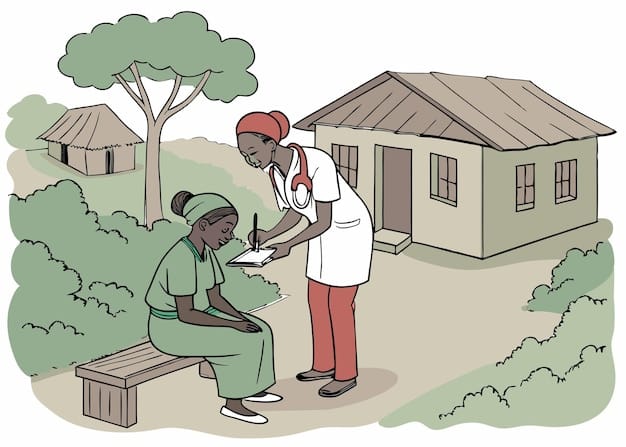US Aid to Developing Nations: Hitting Sustainable Development Goals?

Advertisements
Analyzing the Impact of US Aid on Developing Nations: Are We Achieving Sustainable Development Goals is crucial to understand whether current strategies effectively foster self-sufficiency and long-term progress, moving beyond reactive relief to proactive, sustainable development.
Advertisements
Delving into the intricate dynamics of foreign assistance, this article embarks on an in-depth exploration: Analyzing the Impact of US Aid on Developing Nations: Are We Achieving Sustainable Development Goals? It is a question that resonates with policy-makers, aid organizations, and taxpayers alike, seeking to understand the true efficacy and lasting legacy of America’s global commitment.
The Evolution of US Foreign Aid: From Cold War to SDGs
The landscape of US foreign aid has undergone significant transformations since its inception. Initially rooted in post-World War II reconstruction efforts like the Marshall Plan, its objectives broadened during the Cold War to include geopolitical influence and countering communism. This historical context provides essential background for understanding the current challenges and ambitions surrounding aid effectiveness.
Advertisements
Today, the focus has largely shifted towards fostering sustainable development and addressing global challenges, aligning with the United Nations’ Sustainable Development Goals (SDGs). This redirection reflects a maturing understanding of development, moving beyond immediate relief to long-term capacity building.
Historical Imperatives and Modern Realities
Early US aid policies were often driven by strategic concerns, aiming to stabilize economically fragile regions susceptible to Soviet influence. This approach, while achieving certain geopolitical aims, sometimes overlooked the deeper, systemic issues that hindered long-term development. The challenge now lies in balancing immediate needs with sustainable solutions.
- Post-War Reconstruction: Marshall Plan’s success in rebuilding Europe.
- Cold War Proxy Battles: Aid often tied to political allegiance.
- Shift to Development: Recognizing poverty and inequality as root causes of instability.
- SDG Alignment: A global framework for comprehensive development.
The contemporary framework of US foreign aid is now intricately linked with the SDGs, a collection of 17 global goals adopted by the United Nations in 2015. These goals cover a wide spectrum of issues including poverty, hunger, health, education, climate change, gender equality, water, sanitation, and peace. By aligning aid initiatives with these specific, measurable targets, the US aims to contribute to a more holistic and equitable global future.
However, the transition is not without its complexities. Past strategies, while well-intentioned, occasionally created unintended dependencies or failed to adequately account for local contexts. Learning from these lessons is paramount to ensure that current and future aid programs truly empower developing nations rather than simply providing temporary relief measures.
The evolution from a primarily geopolitical tool to a development-focused instrument underscores a fundamental rethinking of aid’s purpose. It moves from a donor-centric model to one that increasingly emphasizes partnership and shared responsibility in achieving universal human prosperity and environmental sustainability.
Ultimately, analyzing the impact requires a nuanced understanding of these historical shifts and the current commitment to global development benchmarks. This historical perspective allows us to critically assess whether the substantial investments made are truly translating into tangible and sustainable progress on the ground.
Key Sectors of US Aid: Where the Investment Goes
US foreign aid is channeled into a multitude of sectors, reflecting the diverse needs of developing nations. Understanding where these investments are directed is crucial for assessing their potential impact on achieving the SDGs. These sectors range from health and education to economic development and humanitarian assistance, each playing a vital role in the complex tapestry of global development.
Historically, health has been a prominent area of focus, particularly in combating infectious diseases. More recently, there’s been a growing emphasis on climate resilience and governance, acknowledging the interconnectedness of various development challenges. This multi-sectoral approach aims to address immediate crises while building long-term capacity.
Health Initiatives and Their Reach
Major US health initiatives, such as PEPFAR (President’s Emergency Plan for AIDS Relief), have demonstrably saved millions of lives and significantly altered the trajectory of the HIV/AIDS epidemic in numerous African countries. Beyond specific diseases, aid also supports maternal and child health, nutrition programs, and strengthening local health systems.
- Disease Eradication: Polio, smallpox, and neglected tropical diseases.
- Maternal and Child Health: Reducing mortality rates and improving nutrition.
- Health System Strengthening: Training healthcare workers, improving infrastructure.
- Emergency Health Response: Responding to pandemics and outbreaks.
These investments are directly linked to SDG 3 (Good Health and Well-being), aiming to ensure healthy lives and promote well-being for all at all ages. The success of these programs often depends on community engagement, local ownership, and the integration of services into existing national health policies. While impressive strides have been made, challenges such as equitable access, resilient health systems, and emerging disease threats continue to demand attention and resources.

Economic Growth and Governance
Economic development aid seeks to create opportunities for sustainable livelihoods, often through support for small and medium-sized enterprises, infrastructure development, and agricultural productivity. This directly contributes to SDG 8 (Decent Work and Economic Growth) and SDG 9 (Industry, Innovation, and Infrastructure).
Concurrently, governance initiatives focus on promoting transparency, strengthening democratic institutions, and improving public service delivery. Good governance is foundational to effective aid absorption and the sustainable use of resources, aligning with SDG 16 (Peace, Justice, and Strong Institutions).
The effectiveness of aid in these sectors is often contingent on the recipient country’s policy environment and its commitment to reforms. While aid can catalyze growth, it is rarely the sole driver. Sustainable progress requires a concerted effort from both donors and recipient governments, fostering an environment where markets can thrive and institutions can function democratically.
Investing in education, particularly for girls, is another critical component of US aid, impacting not only SDG 4 (Quality Education) but also cross-cutting numerous other goals, as educated populations are better equipped to address health, economic, and environmental challenges. These layered investments illustrate the comprehensive nature of modern aid strategies.
By dissecting where US foreign aid is directed, we begin to form a clearer picture of its potential to contribute to the ambitious Sustainable Development Goals. Each sector carries its own unique set of challenges and opportunities, requiring tailored approaches and continuous evaluation to maximize impact.
Measuring Effectiveness: Challenges and Methodologies
Assessing the true impact of US aid on developing nations is a complex undertaking, fraught with methodological challenges. It’s not simply about tracking dollars spent, but about measuring tangible improvements in people’s lives and sustainable development indicators. This requires robust metrics, long-term perspectives, and an understanding of contextual factors.
One of the primary difficulties lies in attributing specific outcomes solely to aid, given the multitude of factors influencing a nation’s development trajectory. Economic policies, political stability, natural disasters, and global market fluctuations all play significant roles, making direct causation hard to pinpoint.
Attribution and Baselines
Establishing clear baselines before an intervention and carefully tracking changes over time are critical but often challenging due to data scarcity in many developing contexts. Without accurate baseline data, it becomes difficult to definitively say whether observed improvements are a direct result of aid or other concurrent factors.
- Data Scarcity: Lack of comprehensive statistical systems in some nations.
- Counterfactuals: Imagining what would have happened without aid.
- Time Lags: Development impacts often materialize over many years.
- Contextual Nuances: What works in one country may not in another.
Moreover, the impacts of aid are rarely immediate. Investments in education or infrastructure, for example, may take decades to yield their full benefits. This long-term horizon often conflicts with political cycles and the pressure to demonstrate quick results, further complicating accurate measurement.
Methodologies employed include randomized controlled trials (RCTs) for micro-interventions, econometric analysis for macro-level impacts, and qualitative studies to capture nuanced social changes. A blend of these approaches often provides the most comprehensive picture, acknowledging both quantitative and qualitative dimensions of development.
Corruption and Mismanagement
A significant challenge to aid effectiveness is the pervasive issue of corruption and mismanagement in recipient countries. Funds intended for development can be diverted, undermining the intended impact and eroding public trust in aid programs. This necessitates stringent oversight mechanisms and transparency initiatives.
US aid agencies implement various safeguards, including rigorous auditing, conditionality clauses, and direct engagement with local communities and civil society organizations. However, eliminating corruption entirely remains an uphill battle, requiring sustained commitment from both donor and recipient nations.
The shift towards direct budget support has also amplified concerns about accountability, leading many donor countries, including the US, to favor project-specific funding or working through well-vetted non-governmental organizations. This helps ensure funds are used for their intended purpose, though it can also fragment aid efforts.
Evaluating US aid necessitates a frank acknowledgment of these inherent complexities. It’s an ongoing process of learning, adapting, and refining strategies to maximize positive outcomes while mitigating risks. The goal is not just to spend money, but to invest it wisely for lasting change.
Ultimately, a robust measurement framework is essential for accountability, demonstrating to taxpayers that their contributions are indeed making a difference. It also provides valuable insights for improving future aid interventions and ensuring alignment with the Sustainable Development Goals.
Success Stories and Unintended Consequences
While the overall impact of US aid remains a subject of intense debate, numerous success stories demonstrate its potential to catalyze significant positive change. These examples often highlight specific, targeted interventions that have demonstrably improved lives and contributed to sustainable development goals. Yet, it’s equally important to examine the unintended consequences that can arise from aid, both positive and negative.
Success often hinges on strong local partnerships, good governance in recipient countries, and programs tailored to specific local needs rather than a one-size-fits-all approach. When these elements align, aid can indeed be transformative, empowering communities and fostering self-reliance.
Transformative Health Initiatives
The impact of PEPFAR is perhaps one of the most compelling examples of large-scale, transformative US aid. Launched in 2003, it dramatically expanded access to HIV/AIDS prevention, treatment, and care, saving over 20 million lives. This initiative not only addressed a dire public health crisis but also strengthened health systems and reduced stigma.
- PEPFAR: Dramatic reduction in HIV/AIDS mortality and new infections.
- Global Vaccine Initiatives: Support for Gavi and polio eradication efforts.
- Food Security Programs: Reducing malnutrition and enhancing agricultural yields.
- Education for Girls: Empowering women and improving national development indicators.
Beyond health, successes are also seen in food security programs, where aid has boosted agricultural productivity and reduced malnutrition in vulnerable regions. Investments in education, particularly for girls, have yielded long-term benefits by improving literacy, health outcomes, and economic participation, all crucial for achieving the SDGs.
These successes are often characterized by strong political will, both in the US and the recipient country, and a commitment to data-driven decision-making. They serve as blueprints for future aid interventions, emphasizing focused objectives and measurable results.

Dependency and Market Distortion
However, aid is not without its pitfalls. One of the most frequently cited unintended consequences is the creation of dependency, where recipient nations become reliant on external assistance, hindering their ability to develop self-sufficient economies and robust social safety nets. This dependency can stifle local innovation and private sector growth.
Another concern is market distortion, where the influx of free or subsidized goods from aid programs can undermine local industries. For instance, food aid, while critical in emergencies, can depress local food prices, making it difficult for local farmers to compete and potentially discouraging domestic agricultural investment.
The “Dutch disease” phenomenon, wherein large inflows of foreign currency (from aid or natural resources) can strengthen a nation’s currency, making its exports less competitive and imports cheaper, is also a potential concern. This can have detrimental effects on nascent domestic manufacturing sectors.
These unintended consequences highlight the importance of carefully designed aid programs that prioritize capacity building, market development, and strong exit strategies. The goal is to “aid ourselves out of business,” rather than creating perpetual reliance.
Ultimately, a comprehensive evaluation of US aid requires acknowledging both its celebrated triumphs and its complex, sometimes counterproductive, side effects. This balanced perspective is essential for refining strategies and ensuring aid contributes authentically to sustainable development goals rather than inadvertently impeding them.
The Future of US Aid: Innovation and Localization
As the global development landscape continues to evolve, so too must the strategies for US foreign aid. The future of aid is increasingly centered on innovation, localization, and a stronger emphasis on private sector engagement. This shift acknowledges that traditional aid models alone are insufficient to meet the ambitious targets of the Sustainable Development Goals.
There’s a growing recognition that effective development is driven from within, necessitating a move from donor-led initiatives to locally driven solutions. This requires empowering local institutions, fostering homegrown expertise, and respecting cultural contexts.
Leveraging Technology and Private Sector Engagement
Technological advancements offer unprecedented opportunities for more efficient and impactful aid delivery. From mobile banking for financial inclusion to remote sensing for agricultural planning, technology can amplify the reach and effectiveness of development programs. Innovations in renewable energy and digital literacy are particularly promising areas.
- Digital Inclusion: Expanding access to internet and digital services.
- Mobile Health (mHealth): Delivering healthcare information and services via mobile.
- Climate Tech: Investing in climate-resilient agriculture and clean energy.
- FinTech for Development: Facilitating micro-loans and financial literacy.
Equally critical is robust engagement with the private sector. Private investment can far outpace traditional aid flows, bringing not only capital but also expertise, innovation, and market access. Public-private partnerships are becoming a key mechanism for delivering large-scale development projects, especially in infrastructure and job creation.
This engagement moves aid beyond merely providing resources to fostering an environment where sustainable economic activity can flourish. It encourages the growth of local markets and reduces dependency on external funding in the long run.
Localization and Capacity Building
A fundamental shift in future aid approaches involves putting local actors in the driver’s seat. Localization means channeling more aid directly through local organizations and governments, rather than relying on international intermediaries. This approach aims to strengthen local institutions, build capacity, and ensure that interventions are culturally appropriate and responsive to genuine community needs.
Capacity building emphasizes training, knowledge transfer, and institutional strengthening to enable developing nations to manage their own development agendas. This includes supporting education systems, governance reforms, and public administration, moving from a model of aid provision to one of true partnership and empowerment.
Critics argue that localization can sometimes be hindered by a lack of fiduciary oversight or technical capacity within local organizations. However, proponents contend that the benefits of increased ownership and relevance far outweigh these risks, provided appropriate safeguards and support are in place.
The aim is to create self-sustaining systems that can continue to deliver progress long after direct foreign aid has ceased. This forward-looking perspective positions US aid not as an endless handout, but as a strategic investment in shared global prosperity and stability.
The future of US aid is therefore about smart, strategic investments that foster self-reliance, leverage diverse resources, and empower local communities to chart their own course towards achieving the Sustainable Development Goals. It’s a challenging but ultimately more effective path towards global development.
Geopolitical Considerations and Global Partnerships
The impact of US aid extends beyond mere development metrics; it is intricately woven into the fabric of US foreign policy and global geopolitical dynamics. Aid serves as a crucial tool for diplomacy, fostering alliances, and promoting American values and interests abroad. Understanding these broader implications is essential for a comprehensive analysis of its effects.
In an increasingly multipolar world, US aid also plays a role in navigating complex relationships and responding to emerging global challenges. It is not just about poverty reduction, but also about building a more stable and secure international environment.
Aid as a Diplomatic Tool
Foreign aid can be a powerful instrument of soft power, building goodwill and strengthening diplomatic ties with recipient nations. By demonstrating a commitment to global well-being, the US can enhance its influence and legitimacy on the world stage. This can translate into cooperation on issues ranging from counter-terrorism to climate action.
- Building Alliances: Strengthening relationships with key partners.
- Promoting Stability: Addressing root causes of conflict and migration.
- Countering Adversaries: Offering alternatives to malign influences.
- Human Rights Advocacy: Advancing democratic principles and governance.
Conversely, aid can also be used to exert leverage, with conditionality clauses often tied to reforms in governance, human rights, or economic policies. While this can drive positive change, it must be balanced carefully to avoid perceived interference or undermining sovereign decision-making.
The allocation of aid often reflects strategic priorities, supporting countries critical to US national security or economic interests. This geopolitical lens, while sometimes conflicting with purely developmental aims, remains an undeniable factor in aid distribution.
Moreover, in an era of great power competition, US aid serves as a counterweight to the growing influence of other global actors, notably China, who are also investing heavily in developing nations through their own distinct models of engagement. The nature of these alternative models further underscores the importance of the US approach.
Multilateral and Bilateral Cooperation
The US is a significant contributor to multilateral institutions like the World Bank, the International Monetary Fund (IMF), and various UN agencies. Working through these bodies allows for burden-sharing, pooling of expertise, and addressing global challenges that transcend national borders, such as climate change and pandemics. This collective action can achieve a scale of impact that bilateral aid might struggle to match.
At the same time, bilateral aid allows for targeted interventions and direct engagement with specific countries, fostering stronger relationships and enabling flexibility in response to evolving needs. A balanced approach combining both multilateral and bilateral channels is often deemed most effective, leveraging the strengths of each.
Global partnerships extend beyond government-to-government relations to include civil society organizations, private foundations, and the private sector. Collaborative efforts can mobilize diverse resources and perspectives, leading to more innovative and sustainable solutions for development challenges.
Ultimately, the geopolitical dimensions of US aid highlight its multifaceted role: it is a tool for development, diplomacy, and global leadership. Striking the right balance between these objectives is crucial for ensuring that aid remains effective and contributes to a more prosperous and secure world, aligning with the broader aspirations of the Sustainable Development Goals.
Accountability and Transparency in Aid Delivery
Effective aid delivery hinges on robust mechanisms for accountability and transparency. Without clear oversight and public reporting, the risk of inefficiency, waste, and corruption escalates, undermining the very purpose of foreign assistance. Ensuring that aid reaches its intended beneficiaries and achieves its developmental objectives is paramount for maintaining trust and demonstrating impact.
This commitment to accountability extends from the initial allocation of funds to their final expenditure, encompassing every stage of the aid lifecycle. It demands a culture of transparency that empowers stakeholders, both in donor and recipient countries, to monitor and scrutinize aid processes.
Tracking and Reporting Mechanisms
The US government utilizes various tools and platforms to track aid flows and report on results. Agencies like USAID and the State Department are mandated to provide detailed accounts of where funds are allocated, what activities they support, and what outcomes are achieved. Initiatives like the ForeignAssistance.gov website aim to make this information publicly accessible and digestible.
- Public Dashboards: Websites like ForeignAssistance.gov for data access.
- Independent Evaluations: Third-party assessments of program effectiveness.
- Aid Conditionality: Linking aid to performance metrics and governance reforms.
- Whistleblower Protections: Encouraging reporting of misuse of funds.
Despite these efforts, challenges persist in ensuring comprehensive and real-time reporting, especially given the complex web of implementing partners and diverse program types. Furthermore, measuring impact often requires more than just financial accounting; it demands robust qualitative and quantitative data on social and economic changes.
The integration of technology, such as blockchain for financial traceability or satellite imagery for project monitoring, offers promising avenues for enhancing transparency and reducing opportunities for diversion of funds. These tools can provide an unprecedented level of granular detail and verification.
Citizen Participation and Oversight
True accountability extends beyond government agencies to include the active participation of civil society and local communities. Empowering citizens in recipient countries to monitor aid projects, voice concerns, and hold their governments accountable can significantly improve aid effectiveness and ownership.
Local media play a crucial role in investigating and reporting on aid utilization, bringing potential irregularities to light. Supporting independent media and civil society organizations is therefore a critical component of ensuring accountability at the grassroots level.
Donor governments like the US are increasingly incorporating feedback mechanisms from beneficiaries into program design and evaluation, ensuring that aid interventions are genuinely responsive to local needs and perceived effectively by those they aim to serve. This “bottom-up” approach to accountability complements traditional “top-down” oversight.
The ongoing pursuit of greater accountability and transparency is not merely a bureaucratic exercise; it is fundamental to maximizing the positive impact of US aid and ensuring that taxpayer money is utilized wisely to advance the Sustainable Development Goals. It builds public confidence and strengthens the moral imperative for continued global engagement.
In essence, a transparent and accountable aid ecosystem fosters greater efficiency, reduces waste, and ultimately contributes to more sustainable and equitable development outcomes for nations in need. It is a continuous journey of improvement, requiring vigilance and adaptability from all stakeholders.
| Key Aspect | Brief Description |
|---|---|
| 🌍 Aid Evolution | From Cold War strategy to SDG-aligned development focus. |
| 📊 Impact Measurement | Challenges in attribution and data due to complex influencing factors. |
| 💡 Innovation | Future of aid involves leveraging technology and private sector. |
| 🤝 Localization | Empowering local actors for sustainable, self-driven development. |
Frequently Asked Questions about US Foreign Aid
▼
Today, US foreign aid primarily aims to support sustainable development, promote economic growth, strengthen democratic governance, and provide humanitarian assistance. It is increasingly aligned with the United Nations’ Sustainable Development Goals (SDGs) to address global challenges like poverty, health crises, and environmental degradation, fostering long-term stability and self-sufficiency in recipient nations.
▼
US aid contributes significantly to the SDGs by funding programs in key areas. For instance, health initiatives support SDG 3 (Good Health), education programs address SDG 4 (Quality Education), and economic development efforts align with SDG 8 (Decent Work). Aid also targets climate action (SDG 13) and promotes peace and justice (SDG 16), demonstrating a multidimensional approach to global development.
▼
Measuring aid effectiveness faces several challenges, including data scarcity in developing nations, difficulty in attributing specific outcomes solely to aid due to multiple influencing factors, and the long time lags often required for development impacts to materialize. Additionally, issues like corruption and mismanagement in recipient countries can complicate accurate assessment and divert funds from their intended purpose.
▼
While aid is intended to foster self-sufficiency, concerns exist that it can, in some cases, create dependency if not managed carefully. Over-reliance on external funding can hinder the development of local economies and institutions. Modern aid strategies increasingly focus on capacity building, market development, and promoting local ownership to mitigate this risk and ensure sustainable growth.
▼
Future trends in US foreign aid emphasize innovation, localization, and greater private sector engagement. This includes leveraging technology for more efficient delivery, channeling more funds directly through local organizations, and fostering public-private partnerships. The goal is to maximize impact, promote self-reliance, and ensure that aid programs are sustainable and responsive to community-driven needs.
Conclusion
Analyzing the Impact of US Aid on Developing Nations: Are We Achieving Sustainable Development Goals? is a question with a nuanced answer. While historical contexts and evolving priorities reflect a complex journey, significant strides have been made in aligning aid with global development benchmarks, particularly the SDGs. Challenges persist in measurement, attribution, and mitigating unintended consequences like dependency or market distortion. However, a clear trend towards innovation, localization, and enhanced private sector engagement offers promising pathways for future efficacy. Ultimately, US foreign aid remains a critical, multifaceted tool that, when wielded strategically and transparently, holds the potential to not only alleviate suffering but also to foster a more prosperous, stable, and sustainable world.





